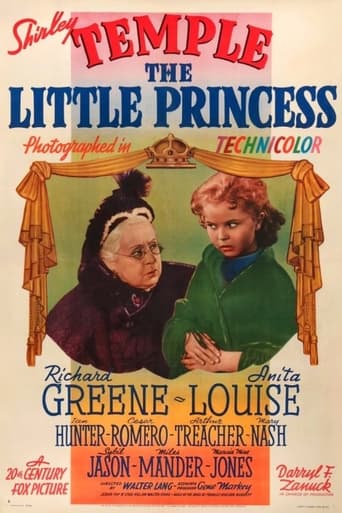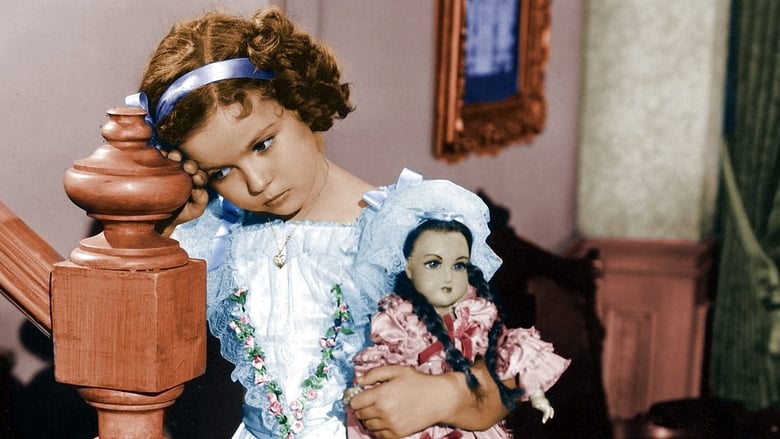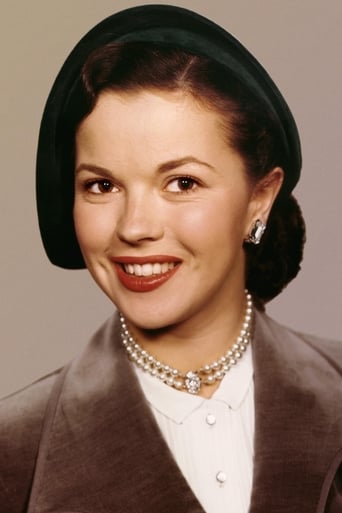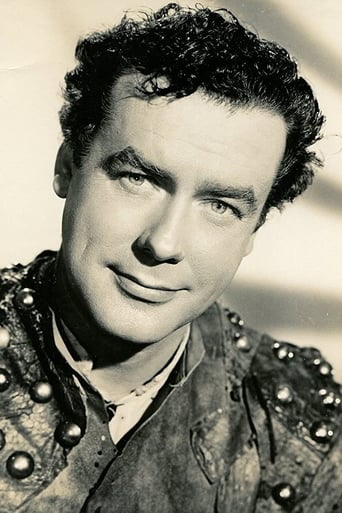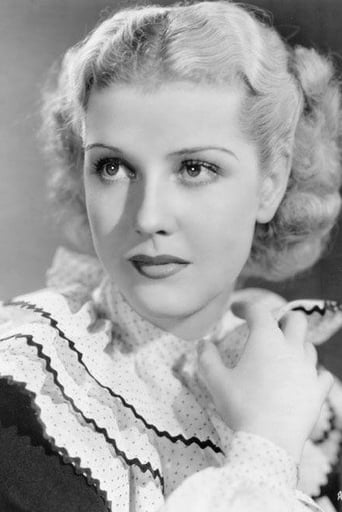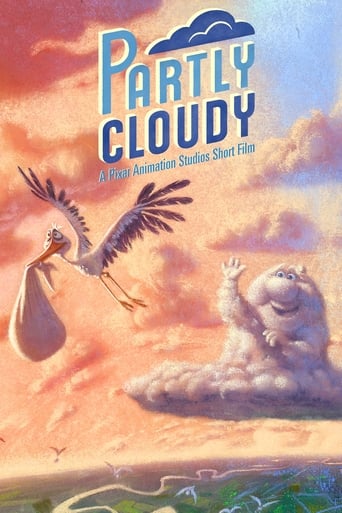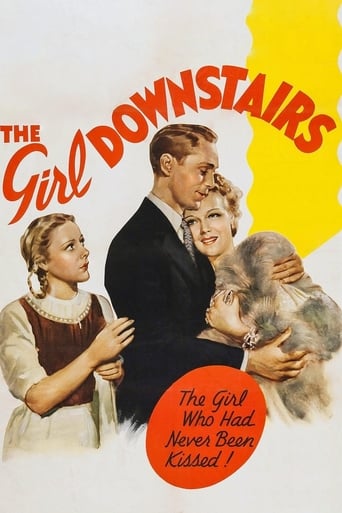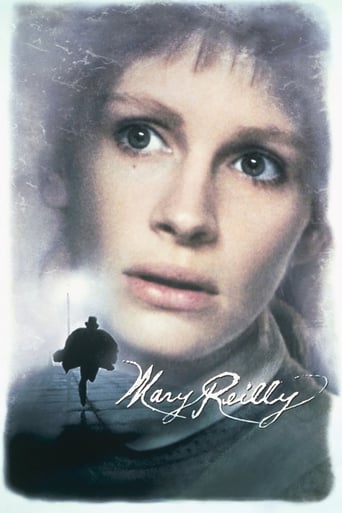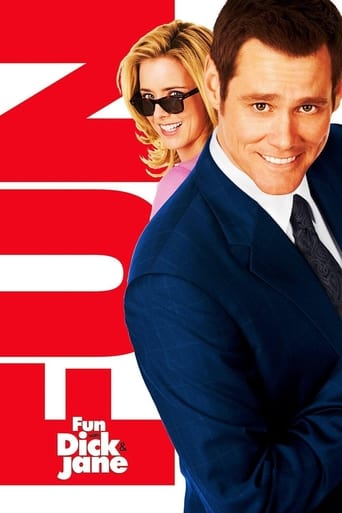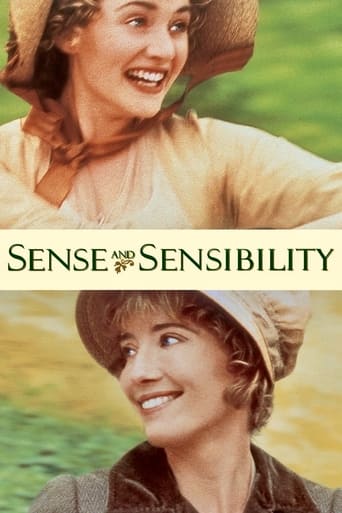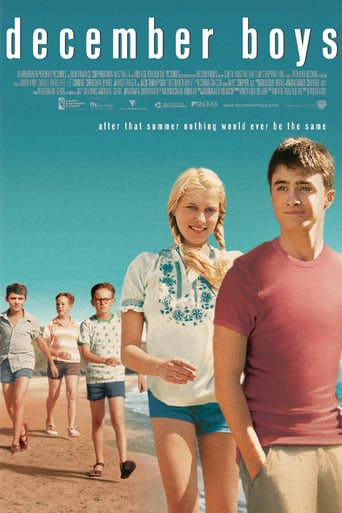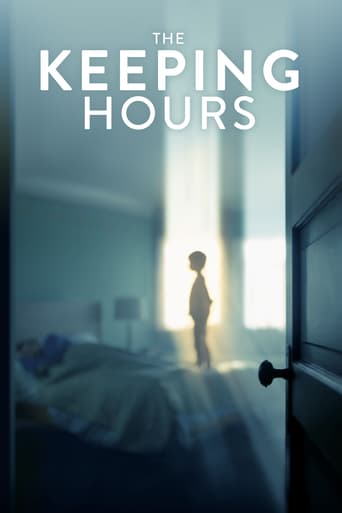The Little Princess (1939)
A little girl goes in search of her father who is reported missing by the military during the Second Boer War.
Watch Trailer
Cast
Similar titles
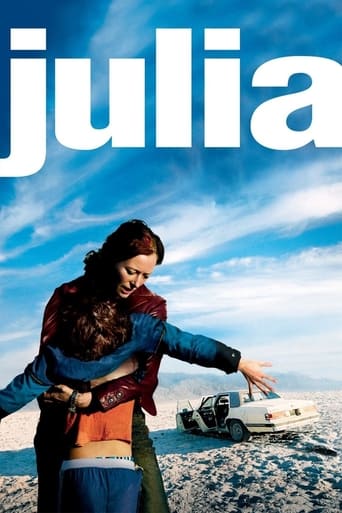
Reviews
Best movie of this year hands down!
I like the storyline of this show,it attract me so much
It's the kind of movie you'll want to see a second time with someone who hasn't seen it yet, to remember what it was like to watch it for the first time.
Although I seem to have had higher expectations than I thought, the movie is super entertaining.
In her later Fox films, Shirley was often cast in stories set in various foreign lands. In "The Stowaway", she was lost in China. In "Wee Willie Winkie", she was in British India. In "Heidi", in Switzerland, and in "Susannah of the Mounties", in Canada. Here, she is the daughter of a British army officer, recently arrived in London from India, immediately sent to fight in the Boer War. It almost seems to begin as a sequel to "Wee Willie Winkie", with British soldiers again marching by, accompanied by bagpipe music. Cesar Romero is back, again as a turbaned East Indian. His character, with the strange name of Rarn Dass, mysteriously pops into her life periodically, as the servant of crusty old Lord Wickham, whose residence happens to be next to that of the exclusive girl's school where Shirley(as Sarah) is deposited while her father is in South Africa.The ingredients of the screenplay pretty much follow the standard formula for most of Shirley's Fox films. As usual, she's cast as an only child, a virtual orphan for much of the film. As usual, she lacks a living mother, but has or develops an unusually close romantic relationship with her father or a father substitute. As in most of her films, she has no significant interaction with boys of her own age, or occasionally a mostly negative interaction with one. As often, she becomes friendly with a young unmarried woman(Rose, in this case), who becomes her mother substitute, and with a young man(Geoffrey, in this case)this woman is developing a romantic relationship with. As usual, there is a grouchy elderly person or two she has to answer to for much of the film. Reprising her antagonistic role in "Heidi", stern -looking and acting Mary Nash plays the headmistress of the school: Amanda. Eily May plays the equally grouchy cook. Actually, I don't find either of these women as unreasonably mean as most children do. They are simply dealing with the problems relating to Sarah in a pragmatic way, for the times. Much worse is Lavinia: the tallest girl in the school, who had been Amanda's favorite before Sarah arrived, and delighted in taunting Sarah with demands, after she was demoted to chargirl. Sarah finally gets her revenge when she dumps a bucket of fireplace ashes on her. Marcia Jones, who played Lavinia, had played a girl with a friendly relationship with Shirley, in the previous "Heidi". Her acting was quite good. As usual, there is a happy ending of sorts. In this case, her presence seems to help her father regain a bit of awareness, after a head wound, in a very teary scene. We aren't allowed to discover how much mental capacity he actually regains, with time.When Sarah arrives at the school, she is soon sarcastically dubbed 'the princess', by the other girls, because her wealthy father seems to treat her as such, and expects others to do likewise. At first, headmistress Amanda reluctantly tries to do so, given her father's clout and wealth. However, when news arrives of her father's apparent death and his funds stop arriving, Sarah's status quickly drops to that of her chargirl friend Becky. It's interesting that, even while she was being treating like a princess by Amanda, she found big-eyed Becky the one girl she felt comfortable confiding in. Rose: her main teacher, becomes her mother-like friend. Geoffrey, her riding instructor and Rose's boyfriend, is also friendly, but soon departs for the Boer War. This leaves Bertie(Arthur Treacher): Amanda's hen-pecked brother, and the mysterious Rarn, as her main male friends. Tall, thin, mop-headed Treacher and Shirley make an odd-looking, if amusing, song and dance couple, in an informal eccentric romp to "Knocked 'em in the Old Kent Road". Later , they do a repeat performance for the benefit of the hospital patients, while Sarah is looking for her father. Treacher is also a delight when he finally gets the nerve to tell off sister Amanda.The inclusion of Queen Victoria, as approving Sarah's seemingly hopeless search for her father among the wounded recent arrivals, is yet another aspect of the general British flag-waving tone of the film. released shortly before hostilities began with a the Nazis. I have to wonder if the screenwriters could foresee what would soon happen. Beryl Mercer makes quite a convincing Victoria, the film ending with Shirley and others saluting her as she leaves the hospital, reminiscent of the ending of "Wee Willie Winkie".The dream fantasy sequence serves to reinstate Sarah, in her mind, as a princess, during a time when she is depressed about her life. She actually functions like a queen, rather than a princess, sitting on a throne, deciding cases brought before her. Later, she sees herself as part of a dance troupe. When she awakes, she finds her formerly drab bedroom filled with pretty objects and clothes, having no idea how they got there. Of course, Amanda quite reasonably assumes she must have stolen them, and goes to the police...In the middle of the film, we have another high, followed by a low, when news arrives that the Boers have been defeated, followed by a lavish birthday party for Sarah, followed by news that her father is probably dead, thus her demotion to chargirl and her move from the best room in the school to the attic. Overall, an entertaining, if occasionally overly corny, S.T. film, in which great pains were taken to recreate an authentic 1899 London. The most expensive of S.T's Fox films to make, and the only one shot in color. Of course, with colorized versions of most of her Fox films now available, this is no longer an important distinction.
When I was a child watching Shirley Temple films on television, I wanted to be Shirley Temple but so didn't everybody. I now realize that even Shirley Temple wanted to be Shirley Temple. She plays Sara Crewe, a captain's daughter, who is left in a London boarding school by a mean governess who runs the school. At first, Sara is treated like a princess but when her father is reported dead, she is moved upstairs to a pitiful attic room. She now must serve her former classmates who taunt her reversal of fortune. Shirley Temple is perfect as Sara. Everybody loves Sara except the mean principal. It's impossible not to love her. The fact that this was in color and filmed in Hollywood in 1939 where they did a superb job in recreating London.
Based on the 1905 novel 'A Little Princess; being the whole story of Sara Crewe' by Frances Hodgson Burnett. The Little Princess was a pretty good adapted movie. I wouldn't say, it's the best adaption of the novel, because it's far from that. In my opinion, the film should had been title 'The Soldier's Daughter' because how different, it was with the novel. Directed by Walter Lang, the movie is about 12 year old, Sara Crewe (Shirley Temple) whom father, Captain Crewe (Ian Hunter) is called to fight in the Second Boer War. Sara is left behind in the care of Amanda Minchin (Mary Nash), the head of an exclusive private school for girls, where she lives in a princess like lifestyle due to her father's riches. Her life as a princess wasn't long, as Captain Crewe's money dry up, and her father is believe to be dead in the battlefield. Miss Minchin harshly force the young woman to serve under her making her life miserable. This doesn't stop Sara's will power and belief that her father isn't dead; and she do anything to find out if he's still alive. Although it maintained the novel's Victorian London setting, the film introduced several new characters like Richard Greene and Anita Louise as the young romantic couple, Sir Geoffrey Hamilton & Miss Rose. They're employees of the boarding school, whom go against the wishes of Miss Minchin. Then there is mean-spirited Lord Wickham (Miles Mander) who has Ram Dass (Cesar Romero) as an Indian servant under him. It isn't really explained why he has an Indian lascar for a servant, and there is no logical explanation for why he would want to redecorate Sara's garret room. I guess, having an Indian sailor next room seem too unrealistic in Victoria Era England to the filmmakers. Another character added is Hubert (Arthur Treacher) who became friends with Sara over music. One thing, way different than the novel is the musical number. I know a lot of Shirley Temple's previous films had this, but this movie lacks music and songs good enough to remember. Shirley Temple and Arthur Treacher had a musical number together, performing the song "Knocked 'Em in the Old Kent Road which was way too short. Temple also appeared in an extended ballet dream sequence that was a bit distracting from the main plot. The whole dream scene was just awful and felt like filler. Another big change is the storyline. The movie used the Second Boer War and the Siege of Mafeking as a backdrop. In the book, the father was just visiting India and got ill to the point, he got brain fever. It wasn't war. The film covers only a timeline of a year, while the book go nearly four years. One of the biggest change in the film is the ending. The film's ending was drastically different. Without spoiling too much of it; this adaptation changes the fate of Captain Crewe. In my opinion, it's a better ending than the book. Still, it's does kinda mess up the plot of a young adult learning how to deal with death and to better herself through the actions of her own well-being. I just didn't like the whole Queen Victoria cameo helping her find her father. It was just outlandish & unrealistic. I can do without all the over Patriotism oozes out of every scene of the film. The main film is about this girl trying to reunite with her father, not the Boer War. Second off, there is no Mr. Thomas Carrisford character in the film. The acting in the film were pretty alright, but nobody really stood out. Shirley looked a little old for the part, but she pulls it off. At the part when she was by the window crying to say goodbye to her daddy was emotional. It was nice to see her react in a film to things like loss and death in a story. The trouble is, she can't pull off the emotion of making herself cry. In the movie, Shirley portrays a child not only with steadfast hope but patience, manners, politeness and kindness in the face of appalling adversity that you rarely see in film today. Who would believe that a child under that pressure could be so gracious? I love when Shirley as Sarah does snap back against her bullies like taunting from Lavinia (Marcia Mae Jones). I have to say, if the film was little bit more dark, it would had work better. It remind me of a Charles Dicken's novel. The director did good on keeping his camera low down, at a child's eye-level. Also striking is his use of multiple angles which really gives dimension to the sets or highlighting a sudden change in mood. This movie was the first Shirley Temple movie to be filmed completely in Technicolor as before that, producers believe these incredibly bright lights produced so much heat that a child, Temple's age would be hurt working under such conditions. Sadly, this was her last major success as a child star. The film is easy to find since it's in the public domain due to the failure to renew its copyright registration. This means that virtually anyone could duplicate and sell a VHS/DVD copy of the film. Therefore, many of the versions of this film available on the market are either severely or usually badly edited. Some DVDs have really extremely poor quality, having been duped from second- or third-generation or more copies of the film. So watch out for that. There are countless remakes of the novel since then. In my opinion: 1995's A Little Princess directed by Alfonso Cuaron was a bit better one than this, but this Little Princess is widely considered to be one of Shirley Temple's best film and I have to agree. Enjoyable tale for children and adults alike. So check it out.
As a kid in parochial school in the late Fifties, an occasional treat called for assembling all eight grades in the auditorium for an afternoon of movies, and I recall Shirley Temple showing up more than once. I don't know if "The Little Princess" might have been one of them, but in any case, she was always a favorite. Shirley may not have had all of the cuteness factor here that was on display in her earlier roles, but there's no denying her talent and presence; when she's on screen, no one else matters. The story here turns somewhat morose when Sara Crewe (Temple) learns her father (Ian Hunter) dies in the Boer War. That's a tough thing to put a kid through, young viewers that is, not the actress. Relating too much to the possibility of a parent's dying isn't exactly the most cheerful subject, so first time viewers of the film are left on the hook for a while until a more successful resolution is arrived at. Along with Shirley, I was also rooting for her compatriot Sybil Jason as the poor, young chambermaid who took a liking to Sara and had the feeling returned in good measure. Interestingly, the Little Princess part of the story was brought into sharper focus when Shirley's character met Queen Victoria (Beryl Mercer), allowing the viewer to consider two different kinds of royalty.
